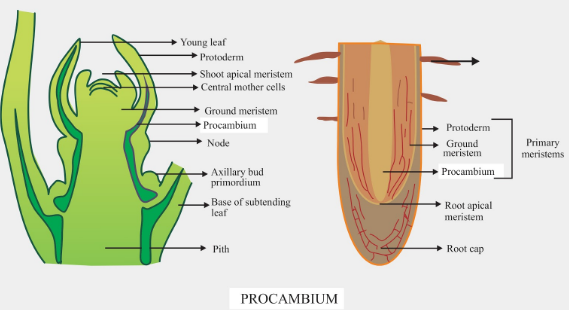
Procambium forms -
(a) Vascular cambium
(b) Vascular tissues
(c) Cork cambium
(d) Intercalary meristem
Answer
529.2k+ views
Hint: Procambium, as seen from the name, is a precursor to cambium which is a meristematic tissue. Meristematic tissues give rise to specific tissues depending on their location. It is also specific to either the root or the shoot.
Complete answer:
Vascular plants grow and develop through the growing parts of the plant that contain meristematic tissue.
- The procambium is a primary meristematic tissue that provides primary tissues, that include xylem and phloem, to the vascular system.
- It lies to the inner side of the protoderm and forms the epidermis.
- The other primary meristems are protoderm and ground meristem.
- Procambium gives rise to the vascular cambium, and cork cambium, secondary meristems.
- Vascular cambium is one of the secondary meristems. It produces secondary xylem and phloem. It is also responsible for the formation of wood in arboraceous plants.
- Cork cambium is also a secondary meristem. It gives rise to the periderm, which later replaces the epidermis.
- Intercalary meristems are present in angiosperm monocot plants. They are responsible for rapid stem elongation in bamboo and damaged leaf repair in grasses.
- The different types of meristems based on the location are apical (at the tips), intercalary (the middle), and lateral (at the sides).
So, the correct answer is ‘vascular tissues’.

Note:
Secondary meristems or lateral meristems surround the established stem of a plant and cause it to grow larger in diameter.
- Ground meristem is composed of parenchyma, collenchyma, and sclerenchyma cells.
- There are a group of cells with stem cell function situated on the top of the meristem. They are known as the central zone.
Complete answer:
Vascular plants grow and develop through the growing parts of the plant that contain meristematic tissue.
- The procambium is a primary meristematic tissue that provides primary tissues, that include xylem and phloem, to the vascular system.
- It lies to the inner side of the protoderm and forms the epidermis.
- The other primary meristems are protoderm and ground meristem.
- Procambium gives rise to the vascular cambium, and cork cambium, secondary meristems.
- Vascular cambium is one of the secondary meristems. It produces secondary xylem and phloem. It is also responsible for the formation of wood in arboraceous plants.
- Cork cambium is also a secondary meristem. It gives rise to the periderm, which later replaces the epidermis.
- Intercalary meristems are present in angiosperm monocot plants. They are responsible for rapid stem elongation in bamboo and damaged leaf repair in grasses.
- The different types of meristems based on the location are apical (at the tips), intercalary (the middle), and lateral (at the sides).
So, the correct answer is ‘vascular tissues’.

Note:
Secondary meristems or lateral meristems surround the established stem of a plant and cause it to grow larger in diameter.
- Ground meristem is composed of parenchyma, collenchyma, and sclerenchyma cells.
- There are a group of cells with stem cell function situated on the top of the meristem. They are known as the central zone.
Recently Updated Pages
Master Class 12 Business Studies: Engaging Questions & Answers for Success

Master Class 12 Economics: Engaging Questions & Answers for Success

Master Class 12 English: Engaging Questions & Answers for Success

Master Class 12 Maths: Engaging Questions & Answers for Success

Master Class 12 Social Science: Engaging Questions & Answers for Success

Master Class 12 Chemistry: Engaging Questions & Answers for Success

Trending doubts
What is meant by exothermic and endothermic reactions class 11 chemistry CBSE

Which animal has three hearts class 11 biology CBSE

10 examples of friction in our daily life

One Metric ton is equal to kg A 10000 B 1000 C 100 class 11 physics CBSE

1 Quintal is equal to a 110 kg b 10 kg c 100kg d 1000 class 11 physics CBSE

Difference Between Prokaryotic Cells and Eukaryotic Cells




